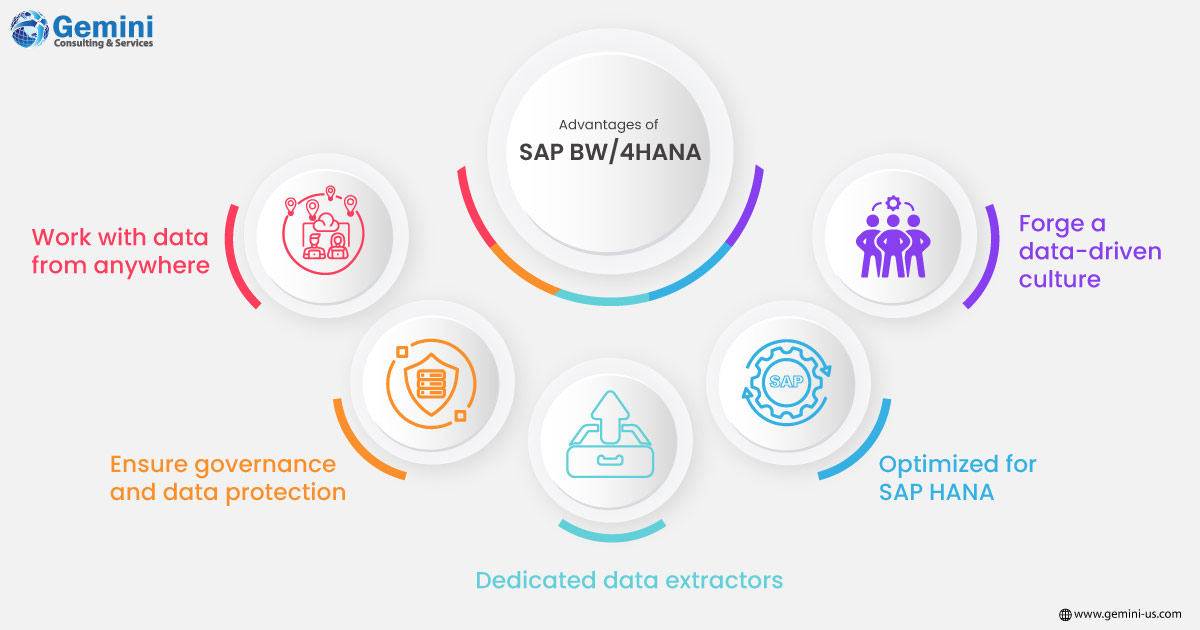Organizations and their IT ecosystems create, access, and leverage a huge amount of data. Businesses deal with data everywhere – in the cloud, in data lakes, in devices, and in other repositories. Apart from the fully structured, transactional data from traditional enterprise systems, a new influx of social and customer behavioral data, massive volumes of sensor and other machine data from the Internet of Things (IoT) have become part of this large data.
Data management solutions that can manage and process internal and external data from a diverse pool of sources hence play a significant role to augment existing enterprise data warehouse strategies. Systematic data warehousing for inter-connected business intelligence requires a sound understanding of how to optimize the use of technology. This forms the building blocks of the right data warehousing solution.
According to Forbes, teams that are looking at building successful data warehouses must understand business use cases and define a data strategy before getting into technological design. Data warehouses can quickly become cost centers if enterprises lose their focus on value and tangible results.
SAP BW/4HANA works on top of HANA. As a data warehouse, the implementation of BW/4HANA helps consolidate data from the entire business. This renders a consistent and unique view of business indicators as it uses the ability to load, transform, clean, enhance, integrate, and manage data from SAP sources, relational databases, enterprise applications, files, social media, etc. SAP BW/4HANA manages all types of data, including structured and unstructured and it can provide access to all models through an open SQL interface. Apart from offering businesses a harmonized view of all functions it enables the comparison of data from a wide variety of sources in real-time.
It is powered by SAP HANA and performs as agile as SAP S/4HANA, working for both cloud and on-premise deployments. A key advantage for SAP customers here is that it can seamlessly integrate with SAP S/4HANA and supports SAP Analytics. This is done using any SQL tool. Enterprises can visualize data in SAP Analytics Cloud (SAC) and add-ons for MS Office and other third-party providers.
As SAP BW/4HANA can be deployed either on-premise or cloud it offers more agility to businesses. SAP BW/4HANA is also available on partner clouds such as Amazon Web Services (AWS). Gemini Consulting & Services can help you develop a strategic data warehouse solution built on SAP BW/4HANA that can accelerate outcomes, eliminate the boundaries between operations and analysis and help decision-makers access data anywhere. Contact us for a detailed discussion on migrating your data environment to SAP B4/HANA.

- SAP BW/4HANA can work with data from anywhere and can quickly consolidate data from multiple data sources, or applications, supporting timely decision-making.
- Its structured development methodology ensures governance and protection for enterprise data assets.
- Dedicated data extractors and pre-built data models accelerate value from SAP systems.
- It is optimized for the SAP HANA platform and offers the best in-memory performance.
Key Features & Advantages of SAP BW/4HANA | |
| BW/4 HANA 2.0 SP07 | |
| SAP HANA’s in-memory technology | |
| Works on top of HANA, Teradata, Sybase IQ and Sybase ASE | |
| Relational databases | |
| Enterprise applications | |
| Integrate social media data | |
| Structured and unstructured data | |
| Open SQL interface | |
| Cloud and on-premise deployments | |
| Direct Connect to AFO, Webi, Power BI, SAC, Tableau and QlikView | |
| SAP S/4HANA: ML as an Extension of SAP/4HANA Process (Python, R) | |
| HANA Views: Predictive Analysis & Lumira 2.0 | |
| Connectivity, data transformation, business logic, scheduling, and data modeling | |
| Ready-to-use data model templates available | |
| Field-based modeling | |
| Real time through remote connections | |
| Automated distribution of data to hot and warm storage areas | |
| Available on partner clouds – AWS | |
| Extraction: SAP Standard Extractors available | |
| Extraction: DB Connect, SLT, SDA and ODP Framework | |
| Extraction :S/4 HANA -> ODP_CDS (HTTP/SOAP Connection) | |
| Extraction: SAP C/4 HANA -> ODP_BYD (HTTP/SOAP Connection) | |
| Extraction: SAP SF ->SAP HANA SDI OData Adapter | |
| Extraction: SAP SF ->SAP Concur SAP Fieldglass — > Sap HANA SDI Cloud Data Integration Adapter | |
| Extraction: Noon Sap — > BODs, PI, Sap Data Intelligence, CPI | |
| Support Open Hub | |
| Modeling: Eclipse view | |
| LSA++ | |
| Business Content | |
| ADSO | |
| Open ODS View | |
| HANA Calculation View | |
| Composite Provider | |
| Enhancements ABAP: COMD exit | |
| Enhancements Sap HANA SQL | |
| Enhancements AMDB | |
| Migration: Sap BW 7.5 to SAP BW/4 HANA starter add-on | |
| Migration: Existing generic extraction will be taken care of by migration tool | |
| Migration: Existing enhanced objects in ECC or BW Lookups will take care of by migration tool | |
| Migration: Existing routines will take care of by migration tool | |
| Migration: Old Bex Queries migration not required | |
| Query Execution: Bex – BICS, OLAP Processor, HANA OLAP Processor | |
| Web-based interface used for administration | |
| BW/4HANA Web Cockpit – Sap Fiori design patterns | |
| SAP BW/4 HANA Maintenance end date by 2040 | |
| Security – Development in BW/4HANA is not changed | |
| Streaming process chain – Real time | |
| Developer advantages – Modeling and user-friendly | |
| Simplified modeling with objects reduced to 4 – ADSO, CP, OPENODS and INFOOBJECT | |
| Time chars available as navigation attributes to 0CALDAY | |
| Separate data flows for different type of notifications (Quality, Maintenance, Customer Service, etc) |
- It is a single one-shot solution that combines connectivity, data transformation, business logic, scheduling, and data modeling.
- It comes with a dedicated functionality designed to handle typical data warehousing challenges such as delta loads, changing dimensions, hierarchies, etc.
- Businesses can combine multiple datasets, prepare and transform data, add calculations and business logic, such as currency conversion, and then finally secure data.
- Since it is built on the SAP HANA platform, BW/4HANA optimizes the latest in in-memory, columnar processing. This combined with a range of data engines helps support all data processing needs.
- BW/4HANA allows the movement of data between its different tiers – from in-memory where speed is critical to data lake storage which can scale easily through the same interface.
- There are free, ready-to-use data model templates designed to help businesses get started with data quickly. It also comes with pre-built content designed to work with SAP applications and allows businesses to start uncovering value right from the start.
- This platform is designed to be the best when working with SAP systems and SAP data and offers better integration and metadata support. Stakeholders can spend more time analyzing data and less time preparing it.
- Tight security controls, mature development lifecycle support, auditing, monitoring, and data protection ensure that there is complete visibility and control over data, however, sensitive it might be.

- SAP BW/4HANA completely utilizes the full performance potential of SAP HANA’s in-memory technology. It also simplifies the formation of complex data models. The future of data warehousing is strengthened by the introduction of new objects. It reduces persistence and replaces the same with new virtual layers. This saves storage space costs and brings down the effort required for projects while increasing flexibility and speed in modeling.
- Enterprises adopt field-based modeling for the rapid implementation and testing of new use cases as it does not require modeling multiple info objects. With SAP BW/4HANA enterprises can access source data in real-time through remote connections and use it for reporting. BW/4HANA is SAP’s strategic tool for on-premise data warehousing.
- With SAP BW/4HANA it is possible for businesses to obtain the full value of their data and drive digitization across functions while leveraging the SAP investment. Setting up the environment is largely simplified due to the concepts of updated modeling and administration features that reduce development and implementation times. The SAP BW/4HANA helps easily integrate SAP and non-SAP applications and data sources. Its intuitive and modern user interface increases user adoption and user productivity. There is very little wait time for data handling as high-volume data processing can happen in real-time.
- Operational and historical analytical needs of data applications are fulfilled by SAP BW/4HANA by working with SAP S/4HANA. As a result, resources get to use fresh data always.
- It leverages smart data integration using a logical data warehouse approach. This eliminates duplication and expensive data movement to connect the data silos across functions.
- Leveraging the data lifecycle features of SAP HANA, SAP BW/4HANA allows for the automated distribution of data to hot and warm storage areas. This in turn helps reduce the total cost of ownership and improves query response time for data warehouses.
- SAP BW/4HANA helps users to improve productivity by utilizing dynamic data distribution by age and data values to provide a user-centric, visually simple interface.
- Enterprises can either work on SAP HANA in BW mode or in native SQL mode. It also offers the choice of switching back and forth between the two.



